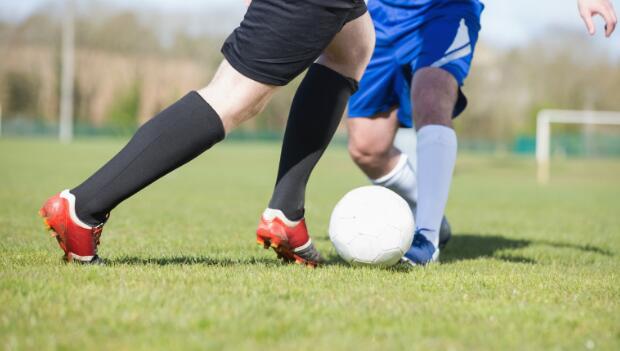
The defender's primary job is to deny penetration. The defender does this by preventing the attacker from either passing forward, dribbling toward the goal or shooting.
This is achieved through pressure and positioning. It's not enough to know what to do, if you aren't in position to do it.
Priorities for a pressuring defender
- Intercept balls passed to the attacker. If the defender can cut off a pass before the individual duel occurs, they've significantly decreased the offensive threat. The defender must be positioned goal-side of the attacker so they can see the ball and their attacker. This way, they're able to see where and how high the ball is being passed.
- Tackle the ball as the attacker makes their turn. If interception failed or wasn't possible, a good option is to tackle the ball before a confrontation with the offensive player.
- Force the attacker to screen the ball with their first touch. Don't allow the attacker an opportunity to turn with the ball and face the goal. A negative first touch means they are moving away from the defender and the goal while screening the ball from the defender.
-
Tackle the attacker halfway through their turn as they attempt to face the defender. A good defender senses when the attacker has committed to turning and is prepared to win the ball when the attacker exposes it.
This is impossible to do unless the defender is within tackling range. As the attacker is shielding the ball and attempting to turn, the defender must keep two things in mind:
- Never lean on the attacker. Good attackers use this over-commitment to their advantage by spinning and playing the ball into the space left open by the defender.
- Never lose sight of the ball.
-
Steer the attacker into the least dangerous space. Once the offensive player has turned, channel them into an area where they will do the least damage or into a supporting defender. Often, this will be the sideline.
The defender now attempts to set a trap. Here, the speed of the approach is crucial. If the defender tries to close down an attacker's space too quickly, the offensive player can play the ball quickly behind the defender, using the defender's speed and aggressiveness to their advantage. If done too slowly, the attacker is given ample time to gain the advantage.
- Recovery runs. If the defender is beaten, a recovery run toward the near post is the fastest way to get goal-side of the attacker. The object is to get in good defending position, between the goal and the ball, as quickly as possible.
Summary
The individual defender is concerned with two things: whether or not to make contact with the ball, and how and where to position oneself.
The first priority of the defender should be to prohibit the ball from reaching the attacker or stopping the attacker from turning goal-side with the ball. If that fails, the defender should contain the offensive player and force them to give up the ball away from the goal or risk being tackled as they turn. Final strategies include maneuvering the attacker into a less dangerous space or getting into position to deflect the attacker's shot or pass.
The defender's role in stopping forward movement by the offense is not limited to overpowering the attacker. They must work to rush, pressure and confuse the attacker, thus causing them to make mistakes. Taking advantage of your opponent's errors makes it easier for you to win the ball and deny penetration toward your goal. A solid defense is a crucial part of a successful soccer team.
 See more soccer drills & tips or find a soccer camp near you.
See more soccer drills & tips or find a soccer camp near you.


